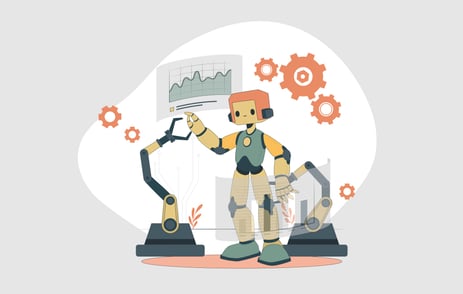In this world of ever-evolving technology, it’s no surprise that the integration of artificial intelligence (AI) with humanoid robots has sparked considerable interest and debate.
With advancements in technology and significant investments from industry giants, the prospect of AI-powered humanoid robots in the workplace is becoming more real.
Below, we explore the potential utility of humanoid robots in various professional settings, examining their capabilities, challenges, and potential impact.
>>> Read more: What AI Technology is Right for My Organization?
Humanoid Robots in the Workplace
The partnership between OpenAI and robotic startup Figure signifies a significant step towards the integration of AI with humanoid robots. Backed by substantial venture capital, Figure aims to introduce human-like robots into both professional and personal environments. While the concept of humanoid robots presents an engaging prospect due to their relatability, practical implementation faces challenges.
Unlike traditional professional robots, which are often tailored for specific tasks, creating humanoid robots capable of versatile and reliable movements poses complex engineering challenges. However, advancements in AI, particularly in computer vision and natural language processing, offer promising avenues for overcoming these obstacles.
The recent demonstration of a humanoid robot by Figure showcased its ability to perform tasks without prior training, relying on advanced AI models for decision-making. This represents a significant advancement in robotics, as it demonstrates the potential for generalized capabilities in humanoid robots, moving beyond specific task training.
Want to learn more about humanoid robots? Tune into episode 23 of the Sidecar Sync podcast on your favorite listening platform!
The Role of AI in Humanoid Robots
The integration of AI, particularly advanced language and vision models, plays a crucial role in enhancing the capabilities of humanoid robots. By leveraging AI-powered reasoning and planning algorithms, these robots can interpret and respond to complex commands and scenarios, mimicking human-like behavior.
For example, the ability of a humanoid robot to understand natural language commands, such as "I'm hungry," and respond by offering food demonstrates the level of reasoning and inference capabilities enabled by AI. While current models may not achieve full artificial general intelligence, they showcase significant progress towards more sophisticated reasoning and decision-making.
Furthermore, AI models like GPT-5 and advanced vision models contribute to the multi-modality of humanoid robots, enabling them to perceive and interact with the environment more effectively. This fusion of language understanding, visual perception, and motor skills enhances the versatility and adaptability of humanoid robots in various workplace scenarios.
Applications of Humanoid Robots in the Workplace
The potential applications of humanoid robots in professional settings are diverse and expansive. From manual labor tasks to customer service and healthcare, humanoid robots can augment human capabilities and address labor shortages in critical industries.
For example, in manufacturing and logistics, humanoid robots equipped with advanced manipulation and navigation capabilities can assist with repetitive tasks, increasing efficiency and productivity. Moreover, in healthcare settings, these robots can support healthcare professionals by lifting and transporting patients, reducing the risk of injuries and improving patient care.
Customer service is another area where humanoid robots can make a significant impact. By leveraging AI-powered language understanding and emotional intelligence, these robots can interact with customers in retail, hospitality, and service industries, providing personalized assistance and enhancing the overall customer experience.
Challenges of Humanoid Robots in the Workplace
Despite the potential benefits, the widespread adoption of humanoid robots in the workplace presents several challenges and considerations. Ethical concerns regarding job displacement, data privacy, and human-robot interaction must be addressed to ensure responsible deployment and usage of AI-powered robots.
Additionally, technical challenges such as ensuring robustness, safety, and reliability in dynamic environments remain significant barriers to overcome. Humanoid robots must demonstrate the ability to operate autonomously and safely alongside humans, without posing risks or disruptions to existing workflows.
Furthermore, regulatory frameworks and standards for AI-powered robots in the workplace are still evolving, requiring collaboration between policymakers, industry stakeholders, and researchers to establish guidelines and best practices.
>>> Read more: The Critical Role of Data in AI
Realize the Full Benefits of Integrating AI into Your Association
The integration of AI-powered humanoid robots in the workplace holds immense potential to transform various industries and redefine the future of work. By leveraging advanced AI technologies, these robots can augment human capabilities, increase productivity, and enhance operational efficiency in diverse professional settings.
However, realizing the full benefits of humanoid robots requires education and addressing technical, ethical, and regulatory challenges while ensuring responsible and ethical deployment. Get started with this by signing up for our free Intro to AI Webinar for Associations and Nonprofits, designed specifically for association members who are new to AI and eager to dive in.

April 3, 2024




